Gallery, 2006 – Archive of Oil Paintings
Viewed: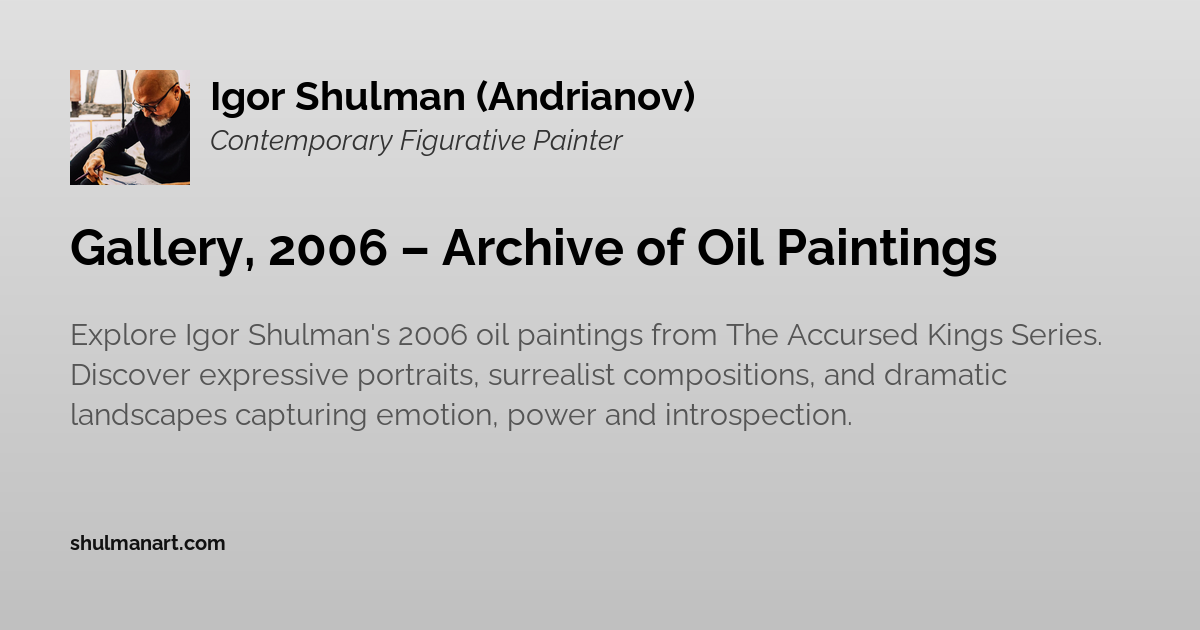
In 2006, Igor Shulman delved into dramatic narratives and expressive figures. His oil paintings explore tension, emotion, and theatrical storytelling, continuing his exploration of human experience.
2006 Archive of Original Oil Paintings
Explore the archived oil paintings created by Igor Shulman in 2006. This collection emphasizes dramatic compositions, intense emotional expression, and theatrical scenes, reflecting his evolving mastery of portraiture and narrative in oil.
Browse All Available Oil Paintings
View the full oil paintings catalogue
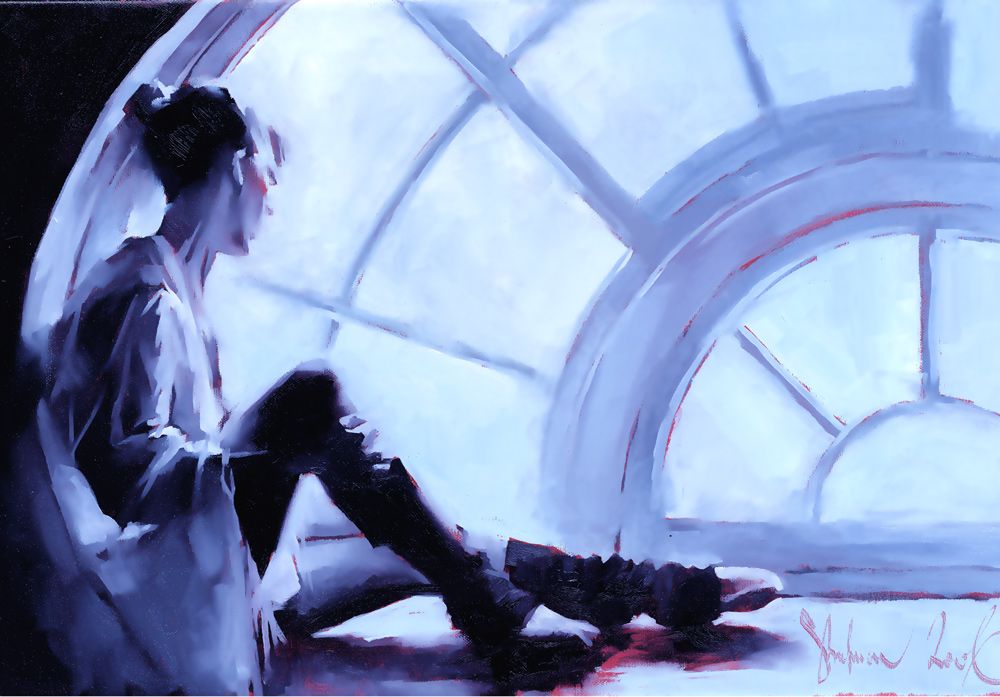
Dancer by the Window
Dancer by the Window (2006) by Igor Shulman portrays a quiet moment of introspection and solitude. A young woman sits by a towering, arched window, her legs tucked beneath her body in a pensive pose. Her hair is pulled back in a bun, and she wears a flowing robe rendered in muted shades of grayish-blue, purple, and lavender. The details of her face remain soft and indistinct, allowing her silhouette and posture to carry the emotional weight of the scene.
The immense window behind her dominates the composition, its segmented panes forming a lattice that diffuses the light streaming in from outside. The cool tones of pale blue and lavender wash across the figure, creating a calm yet slightly melancholic atmosphere. The interplay of warm reddish-purple tones in the lower portion of the canvas with the cooler light above introduces a delicate balance between warmth and solitude.
Shulman employs an impressionistic style, with visible brushstrokes that emphasize mood and atmosphere over strict realism. The layered application of oil paint creates depth and subtle variation, while the simplified shapes and softened contours direct the focus toward the emotional resonance of the scene.
The painting evokes a mood of quiet contemplation, peaceful yet tinged with melancholy. The woman’s pose and the vast window suggest both introspection and longing—perhaps a reflection on the past or a moment of waiting for what lies beyond. Symbolically, the window can be read as a threshold, a metaphorical opening to another stage of life or a distant hope. With its cool palette and serene mood, Dancer by the Window embodies Shulman’s ability to capture intimate human emotion within timeless, atmospheric spaces.
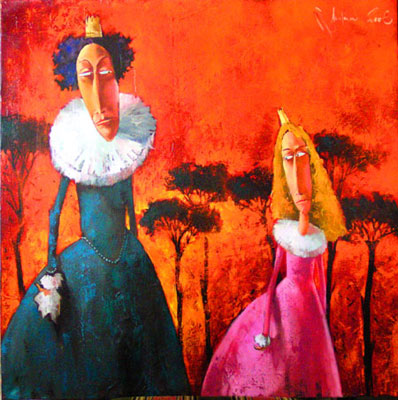
Untitled (Mother and Daughter Queens)
27.56 H x 27.56 W x 1.97″ x / 70 H x 70 W x 5 cm
This artwork is a part of The Accursed Kings Series
Untitled (Mother and Daughter Queens) (2006) by Igor Shulman is a dramatic and surreal exploration of power, inheritance, and generational tension. The painting portrays two stylized female figures, both wearing crowns, standing against a fiery red and orange background. Their regal attire and solemn postures hint at their royal status, while their contrasting expressions suggest a more complex emotional narrative.
The taller queen, dressed in a long teal gown with a large Elizabethan-style ruffled collar, appears somber and dignified. She holds a small white object—perhaps a bird, cloth, or symbolic token—that adds ambiguity to her role. Her elongated features, pale complexion, and dark curls lend her a theatrical, almost caricature-like quality. Beside her, a younger queen in a pink gown with a similar white ruff and crown exudes a more resigned, melancholic air. Her posture mirrors the older figure but with softer edges, evoking a sense of wistful submission or quiet defiance.
The background is painted with bold, impasto strokes of intense crimson, orange, and hints of black, suggesting either a burning sky at sunset or an apocalyptic landscape. Dark, silhouetted trees rise starkly against the fiery glow, amplifying the tension and drama of the scene.
Shulman’s style combines surrealism with expressionistic brushwork, using exaggerated proportions, impasto textures, and bold colors to create a highly charged atmosphere. The painting’s mood is both theatrical and introspective, evoking themes of succession, rivalry, and the burdens of inherited power. The crowns symbolize authority, while the oppressive, fiery landscape mirrors the emotional weight of their relationship. Viewers are invited to interpret the dynamic as mother and daughter, ruler and heir, or two aspects of a single psyche in conflict.
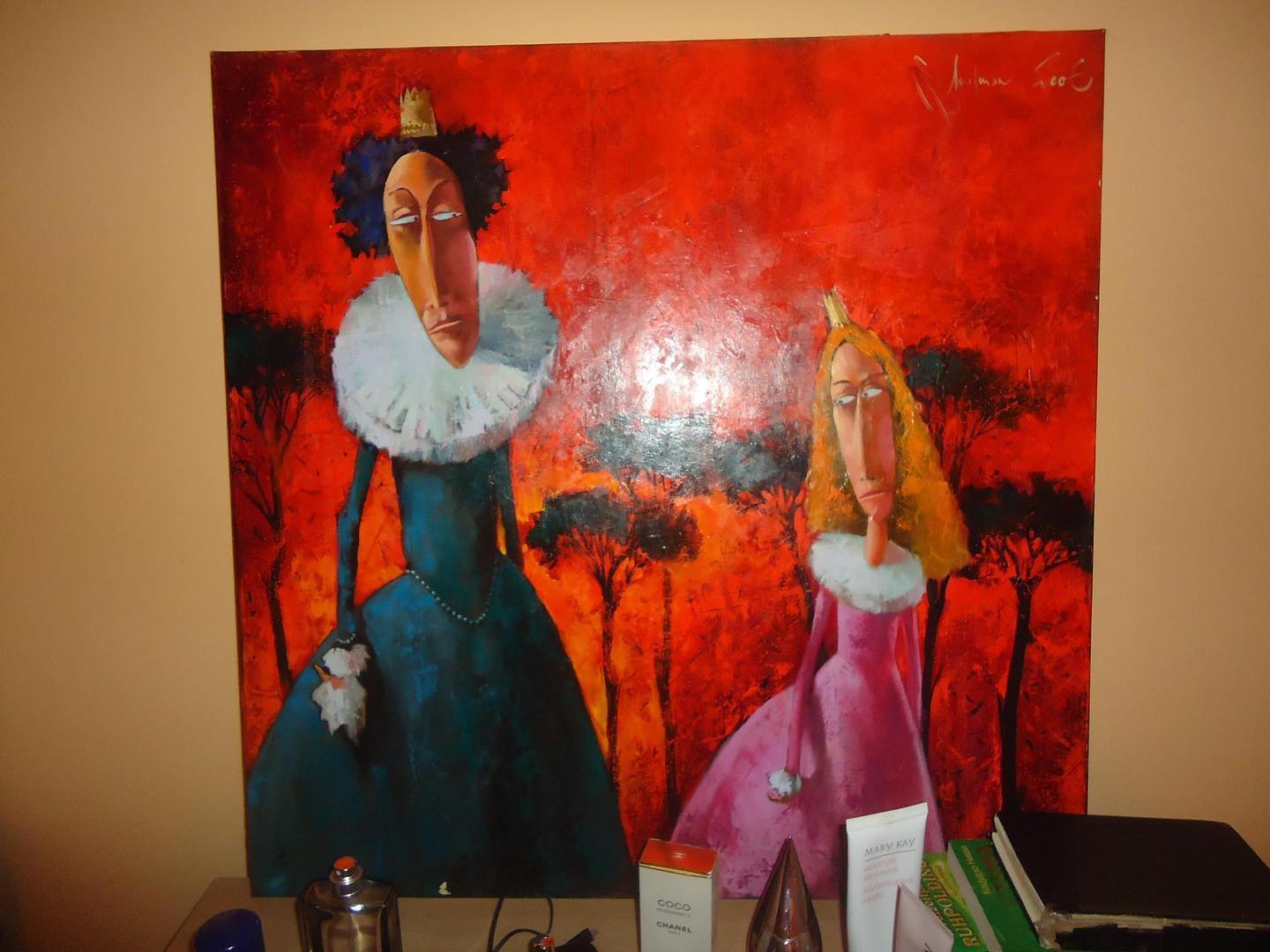
Close-up detail of Untitled (Mother and Daughter Queens) on the Wall
The overall atmosphere is one of mystery and foreboding, hinting at a story or narrative that’s left for the viewer to interpret. The painting explores themes of power, transition, and possibly rivalry or succession.
The two queens, similar in appearance yet distinct in dress and even personality, could represent different aspects of the same authority, maybe a mother and daughter, or even different facets of the same personality. The fiery backdrop may symbolize conflict, change, or the ephemeral nature of power.
The crown symbolizes royalty and stature, and the stiff postures suggest the weight of responsibility or the constraints of social station.
The painting invites viewers to ponder the relationship between the two figures and the meaning of their shared, unsettling environment.
The two queens, similar in appearance yet distinct in dress and even personality, could represent different aspects of the same authority, maybe a mother and daughter, or even different facets of the same personality. The fiery backdrop may symbolize conflict, change, or the ephemeral nature of power.
The crown symbolizes royalty and stature, and the stiff postures suggest the weight of responsibility or the constraints of social station.
The painting invites viewers to ponder the relationship between the two figures and the meaning of their shared, unsettling environment.
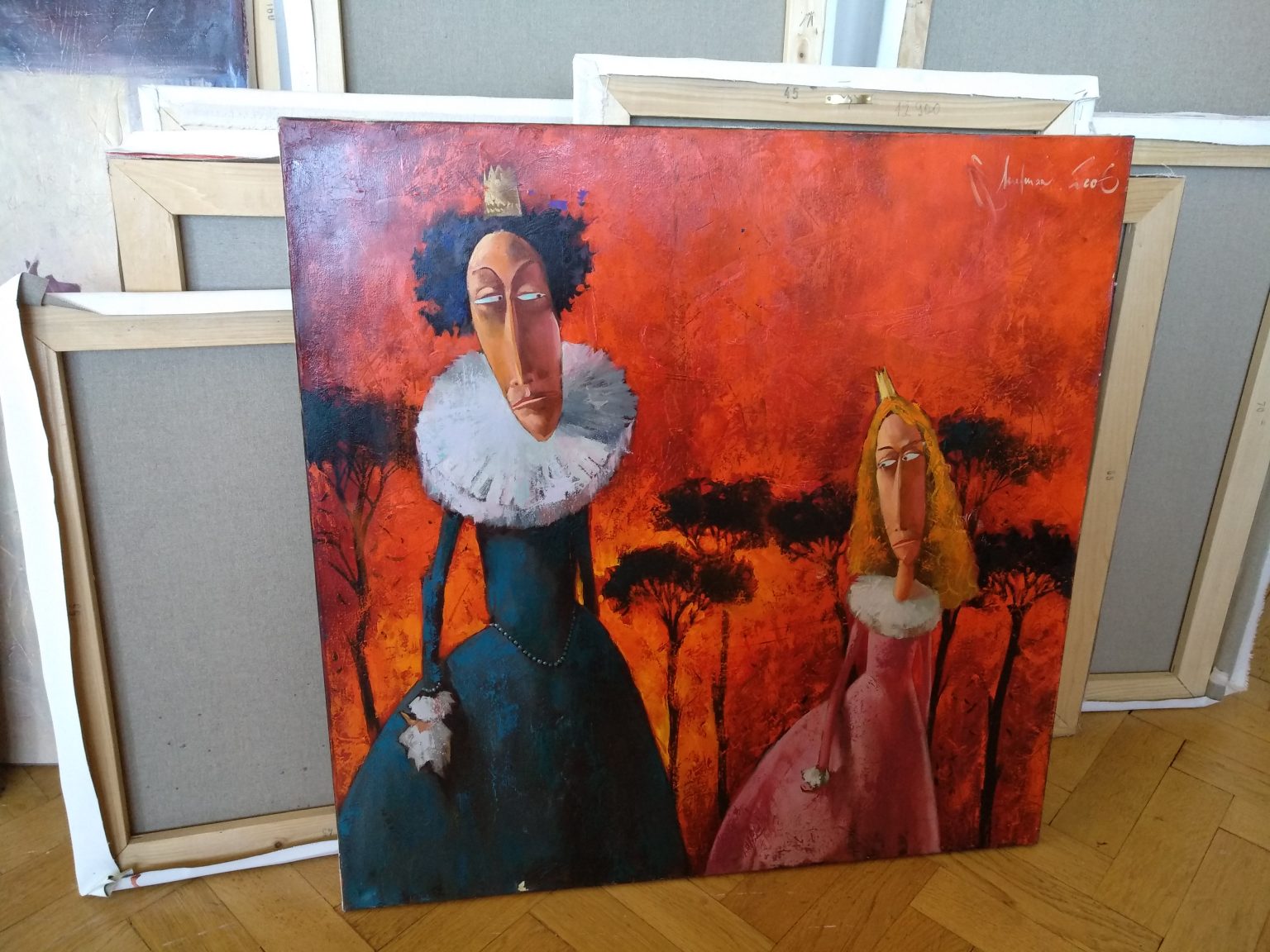
Close-up detail of Untitled (Mother and Daughter Queens), at the Igor's studio
At Igor Shulman Studio. Behind the scenes.
Igor employs a style that blends elements of surrealism and expressionism. The figures are stylized, almost caricature-like in their proportions and features, adding a touch of whimsy. The expressive brushstrokes in the background and bolder, more defined lines outlining the figures show a clear, strong use of contrasting techniques to emphasize the characters and the setting.
The impasto style, with thick layers of paint visible on the canvas, provides an appealing tactile dimension to the work. The overall effect is one of both theatrical drama and subtle emotional intensity.
The artwork exudes a mood of quiet tension and unspoken drama. The intense red background suggests passion, conflict, or perhaps even danger. The queens' expressions—the first a stoic sadness, the second a pensive melancholy—create a sense of anticipation or uncertainty.
Igor employs a style that blends elements of surrealism and expressionism. The figures are stylized, almost caricature-like in their proportions and features, adding a touch of whimsy. The expressive brushstrokes in the background and bolder, more defined lines outlining the figures show a clear, strong use of contrasting techniques to emphasize the characters and the setting.
The impasto style, with thick layers of paint visible on the canvas, provides an appealing tactile dimension to the work. The overall effect is one of both theatrical drama and subtle emotional intensity.
The artwork exudes a mood of quiet tension and unspoken drama. The intense red background suggests passion, conflict, or perhaps even danger. The queens' expressions—the first a stoic sadness, the second a pensive melancholy—create a sense of anticipation or uncertainty.
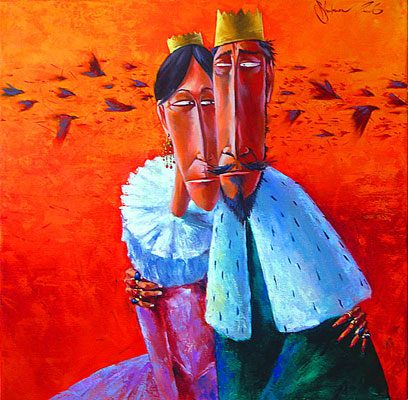
Untitled (King and Queen Embrace)
27.56 H x 27.56 W x 1.97″ x / 70 H x 70 W x 5 cm
This artwork is a part of The Accursed Kings Series
In Untitled (King and Queen Embrace) by Igor Shulman, the royal couple is portrayed in a tense and intimate union. The main subjects—the king and queen—stand at the center, crowned and rigid, their elongated features emphasizing both dignity and unease. The king, robed in blue with a golden crown, clasps his queen’s waist with hands adorned by rings, his expression stern yet weary. The queen, dressed in a pink gown with a dramatic ruffled collar, mirrors his stiffness but carries a quiet vulnerability. Her downcast eyes and delicate earrings accentuate her apprehension.
Behind them, the setting radiates with fiery orange tones, textured and raw, suggesting a vast desolate landscape. A dark flock of birds sweeps across this glowing backdrop, adding urgency and motion, as though fleeing some unseen catastrophe. Their flight heightens the sense of instability, setting the couple in stark contrast to the surrounding chaos.
Shulman’s style is expressive and gestural, with elongated proportions that verge on the surreal. The brushwork remains visible, carrying a tactile immediacy that intensifies the atmosphere. The interplay of bold colors and dramatic composition reflects the artist’s figurative style, yet with undertones of psychological realism.
The mood is heavy with tension: affection and dependence intertwine with fear and fragility. The crown and regal attire symbolize authority, yet the embrace betrays desperation. The fiery background evokes turmoil, while the birds become emblems of loss and disarray. Together, these elements weave a narrative about the burden of power, the fragility of rule, and the human need for closeness when faced with overwhelming forces.
Keywords: original oil painting, artwork by Igor Shulman, figurative style, Untitled (King and Queen Embrace) by Igor Shulman.
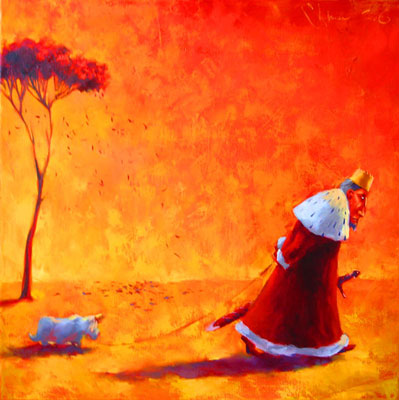
Untitled (Forlorn King with Dog)
27.56 H x 27.56 W x 1.97″ x / 70 H x 70 W x 5 cm
This artwork is a part of The Accursed Kings Series
In Untitled (Forlorn King with Dog), Igor Shulman turns his gaze to the decline of power and the solitude that follows its loss. The main subject, an aged king, is presented in a crimson robe trimmed with fur, his golden crown resting askew on his weary head. His figure is hunched, his steps slow and burdened, embodying exhaustion and the emptiness of former glory. His face, touched by shadow, communicates sorrow and disillusionment. Behind him trails a small, pale dog, passive and subdued, a faint reminder of loyalty but also of insignificance. Walking just ahead, a small white animal—perhaps a lamb—moves with indifference, contrasting sharply with the king’s despair.
The setting is a barren, scorched landscape beneath a burning orange sky. The background’s rough texture, broken by streaks of darker red and orange, evokes falling embers or the remnants of decay. A lone, leafless tree stands in the distance, amplifying the sense of isolation. Shadows stretch long across the ground, casting the king’s solitude into sharp relief.
Shulman’s technique is bold and expressive, with thick brushstrokes and a palette dominated by fiery hues. The painting’s figurative style draws on expressionist traditions, prioritizing emotion over realism. The king’s diminished form becomes a vessel for universal feelings of decline and resignation.
The atmosphere is heavy with melancholy. The fiery sky suggests the end of an era, while the dog and barren landscape symbolize what remains when power fades. Themes of mortality, downfall, and the fleeting nature of authority resonate throughout, offering a poignant meditation on human vulnerability and the limits of control.
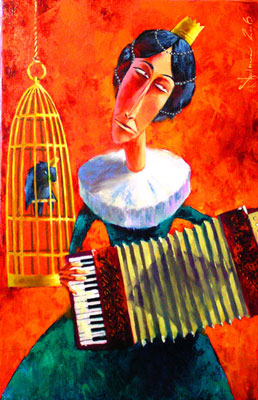
Untitled (Accordion Player with Caged Bird)
This artwork is a part of The Accursed Kings Series
In Untitled (Accordion Player with Caged Bird), Igor Shulman presents a strikingly symbolic scene where creativity and confinement coexist in uneasy balance. The central figure, a crowned woman, sits upright with an accordion resting in her hands. Her face, elongated and solemn, carries a quiet melancholy. Dark beads frame her crown, adding weight to her regal bearing. Dressed in a deep teal gown with a wide, white ruffled collar, she projects dignity, though her expression suggests inner fatigue or resignation.
Beside her hangs a golden cage containing a dark, hunched bird. The cage glimmers against the fiery orange backdrop, its bars rigid against the bird’s fragile form. The juxtaposition of the woman’s poised music-making and the caged creature establishes the painting’s central tension: freedom curtailed, yet creativity still alive.
The background is stripped of detail, a bold expanse of blazing orange that contrasts sharply with the cooler tones of her dress and the metallic sheen of the cage. The surface is richly textured, with thick brushstrokes applied in layers, lending the painting a tactile, almost sculptural quality. Shulman’s expressive figurative style borders on the surreal, where proportions and colors carry symbolic weight rather than descriptive fidelity.
The mood is one of bittersweet resolve. The woman plays, her hands active yet her gaze withdrawn, as if her music is both a solace and a burden. The crown can be read as a symbol of imposed duty, while the accordion, often tied to festive melodies, here conveys introspection. The caged bird echoes her own sense of restriction, a metaphor for the way life and circumstance can confine even the creative spirit. Yet within this confinement, art endures, carrying both beauty and sorrow.
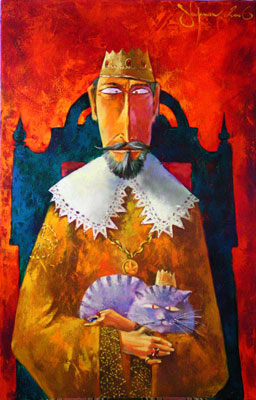
Untitled (King with Purple Cat)
This artwork is a part of The Accursed Kings Series
In Untitled (King with Purple Cat), Igor Shulman combines regal imagery with a touch of irony, creating a work that questions the very nature of power and companionship. At the center sits a crowned king, his elongated face and solemn expression framed by a stiff white collar and heavy golden chain. His mustard-yellow robe adds warmth against the darker tones of the throne. Though his posture is formal, there is a subtle weariness in his gaze, as though the weight of authority has dulled its allure.
Cradled in his arms is a strikingly unusual figure—a large purple cat, complete with its own tiny crown. The animal’s presence is both tender and absurd. Its lavender fur contrasts sharply with the king’s attire and the fiery red background, drawing the eye immediately. The cat’s steady, almost challenging gaze brings an unexpected counterpoint to the king’s guarded solemnity, shifting the painting from solemn portraiture into a symbolic dialogue.
Behind them, the backdrop glows with rough, textured strokes of red, orange, and black, suggesting a stormy or even apocalyptic environment. The ornate throne anchors the figure in tradition and grandeur, while the chaotic background evokes instability, as though power exists only against the constant threat of dissolution.
Shulman’s style here is expressive and gestural, blending caricature-like exaggeration with carefully rendered detail. The impasto background contrasts with the smooth handling of the king’s robe, underscoring the tension between order and disorder.
The painting’s mood is layered: stately on one hand, faintly absurd on the other. Themes of loneliness, authority, and unlikely comfort come forward. The king, surrounded by chaos, finds solace not in subjects or advisors, but in the unlikely companionship of a crowned cat—an ironic yet deeply human reminder of the need for connection.
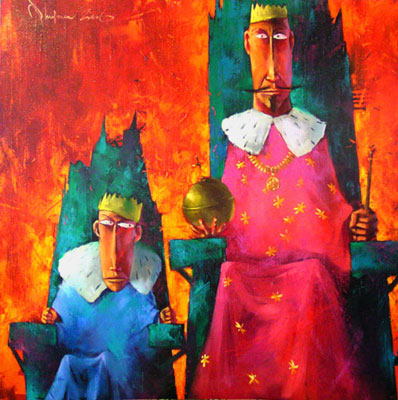
Untitled (Two Kings on Thrones)
27.56 H x 27.56 W x 1.97″ x / 70 H x 70 W x 5 cm
This artwork is a part of The Accursed Kings Series
Untitled (Two Kings on Thrones) by Igor Shulman is an original oil painting that explores power, legacy, and the quiet weight of leadership. The main subjects are two kings seated on elaborate green thrones. The elder king wears a pink robe patterned with gold stars, trimmed with fur, and crowned with authority. His long face and stern, unsmiling expression carry an air of fatigue, as though centuries of rule have pressed into his posture. In contrast, the younger king in blue mirrors his elder’s formality but carries less certainty in his stance. His gaze is thoughtful, touched by apprehension, as if aware of the responsibilities that await him but not yet prepared to bear them fully.
The setting intensifies the tension: a fiery background of red and orange, applied with thick impasto strokes, surrounds the figures with heat and turbulence. This backdrop suggests a kingdom unsettled, perhaps threatened, and casts the kings in an atmosphere of solemnity and strain.
Shulman’s style blends figurative clarity with expressionist exaggeration. The defined outlines and textured surfaces heighten the emotional force, while the limited palette reinforces contrasts between stability and unrest. The crowns, orbs, and thrones act as symbols of dynastic continuity, authority, and the burdens of governance.
The mood is heavy yet reflective, offering viewers not only a scene of regal power but also a meditation on succession, duty, and the personal cost of rule. This figurative style artwork by Igor Shulman resonates as both a portrait of authority and a study of human vulnerability beneath the weight of tradition.
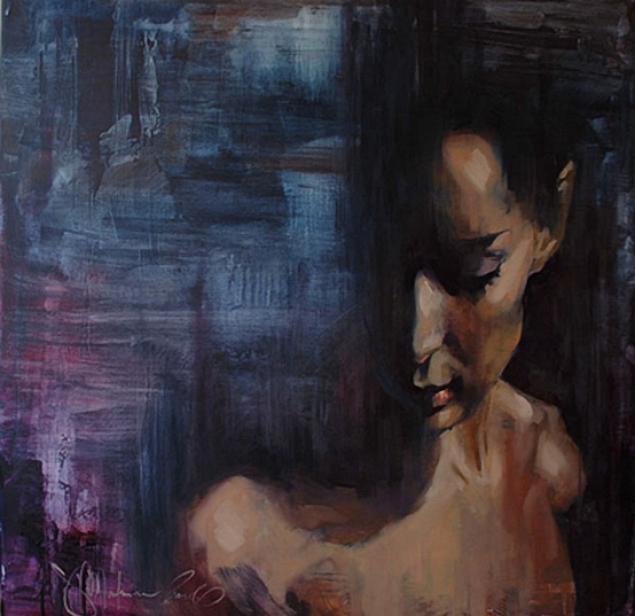
Untitled (Veiled Reverie)
The painting focuses on a solitary woman, her face partially veiled in shadow, capturing a quiet, introspective moment. She sits with her shoulders slightly hunched, head bowed, and gaze lowered, evoking a sense of vulnerability and emotional depth. Her muted skin tones, blending light browns and beige, contrast gently with the dark, smoky background, drawing the viewer’s attention to her subtle expressions.
The setting is abstract, dominated by deep blues, purples, and browns, rendered with layered brushstrokes that create a brooding, almost melancholic atmosphere. The textures are rich and impasto, giving a tactile sense of depth while keeping the environment undefined, emphasizing the woman's isolation. Soft, diffused light contours her features, enhancing the mood of private reflection.
Shulman employs expressive realism with loose, gestural brushwork that balances careful rendering of the figure with energetic, textured paint application. The interplay of the realistic figure against the abstract background generates a tension between clarity and ambiguity, focusing on emotion over precise anatomical detail.
The painting conveys introspection, solitude, and quiet melancholy. The woman's posture and expression suggest internal reflection, hinting at hidden struggles or unresolved thoughts. Symbolically, the dark, abstract backdrop represents emotional weight, while her secluded pose embodies the complex landscape of inner life. This artwork captures the delicate balance between the visible and unseen aspects of human emotion, inviting viewers to contemplate the depths of a private, unspoken world.
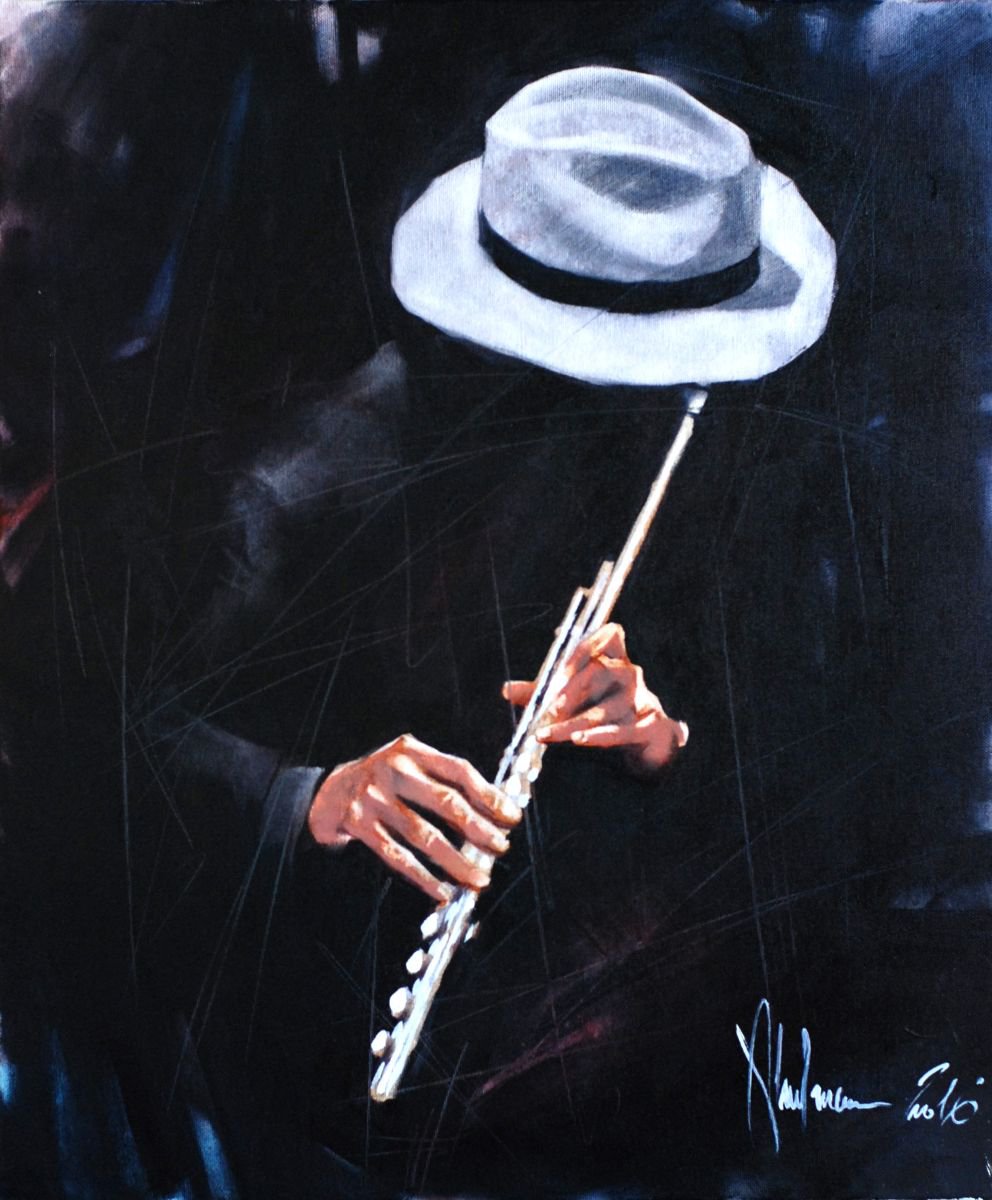
The Flutist
The Flutist draws you into a shadowy world of music and mystery. A solitary musician, their face obscured beneath a light grey fedora, holds a gleaming silver flute with delicate, focused hands. The composition is steeped in rich contrasts of light and dark, highlighting the intimate act of playing while cloaking the figure in expressive shadows.
The deeply textured background pulses with dark brushstrokes—almost scratch-like—tinged with hints of burgundy and deep purple, suggesting layers of emotion and movement beyond the visible. The artist’s use of impasto oil technique and bold chiaroscuro fosters a moody, contemplative atmosphere, where the music feels almost tangible through the strokes.
This painting captures not only the physicality of performance but also the emotional solitude and introspection of the artist. The anonymity of the flutist invites viewers to fold their own stories into the scene, while the focused light on the hands and flute celebrates creative expression as a quiet yet powerful force that transcends the mundane.
The Flutist is a tribute to the profound connection between artist and art—the silent beauty and emotional depth conveyed through music and gesture, framed within a haunting yet intimate visual experience.
The deeply textured background pulses with dark brushstrokes—almost scratch-like—tinged with hints of burgundy and deep purple, suggesting layers of emotion and movement beyond the visible. The artist’s use of impasto oil technique and bold chiaroscuro fosters a moody, contemplative atmosphere, where the music feels almost tangible through the strokes.
This painting captures not only the physicality of performance but also the emotional solitude and introspection of the artist. The anonymity of the flutist invites viewers to fold their own stories into the scene, while the focused light on the hands and flute celebrates creative expression as a quiet yet powerful force that transcends the mundane.
The Flutist is a tribute to the profound connection between artist and art—the silent beauty and emotional depth conveyed through music and gesture, framed within a haunting yet intimate visual experience.
Some archived artworks may be available as prints upon request. Learn more.